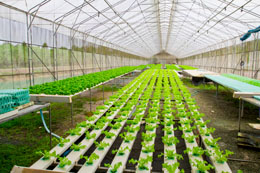The deep water culture is one of the most popular hydroponics systems, which uses a mineral solution instead of soil to grow plants. The following article provides information on the setup and procedure of running this system. It also gives vital tips to run the setup very efficiently.

Deep water culture system, also known as bubbler, is the simplest and probably the most reliable method of plant production. It is a form of hydroponics gardening, where plants are grown by means of suspending their roots in a solution containing oxygenated water, which is rich in nutrients essential for plant growth. These setups are very simple in design and are user-friendly. Moreover, they are not very expensive and easy to manage. This type of water culture is mostly preferred by those who wish to cultivate a minimal number of plants.
Setup
Traditional setups consist of plastic buckets and large containers where the plant is suspended from the center of the lid. The roots suspend in the nutrient rich solution that is contained in the bucket. An air pump combined with porous stones is used to oxygenate the solution. The plants receive a high amount of oxygen through this method, and thus grow faster.
Things Required:
- A large bucket
- Air pump
- Aquarium air stones
- Net pots
- Hydroponic growing net
- Hydroponics nutrients
- Knife or cutter
- Styrofoam
Directions:
The basic idea of this system is to suspend the plant in the nutrient solution with the help of the lid or floaters.
- Cut a hole in the lid of the bucket to fit the net exactly through it. Make sure the hole is such that no extra light enters the reservoir, i.e., the bucket.
- Cut another hole in the lid to fit the air hose of the pump. Run the air line through it to the bottom of the bucket.
- Now fill the net with hydroponics growing mediums like rock wool, expanded clay, or grow rocks.
- If you intend to suspend the plants using floaters, you can use Styrofoam. You can cut individual floaters for each plant or use the entire piece floating on the solution. Adjust the net pots so that they are halfway through the Styrofoam piece.
- Install an air pump at the bottom of the bucket. Attach air stones to the pump.
- Fill the bucket with the hydroponics nutrient solution.
- Now float the Styrofoam, containing the pots, on top of the solution.
Tips to Improve Efficiency
- The medium used for the bubbler system plays a significant role in the growth of the plants. Different types of media are used for different techniques. Choose the appropriate medium for your particular system.
- Next comes the nutrient solution. There are scores of recipes available for nutrient mixes. Make sure that you choose the hydroponic solution that contains all the essential nutrients. The pH should be adjusted between 5.5 and 6.8, every time you refill the tank.
- The more the solution is aerated, the healthier the roots will be and faster will they grow. Hence, make sure you install a high quality air pump, which provides sufficient oxygen to the plants. The supply of oxygen also depends on the type and number of air stones used. Use air stones that produce smallest possible bubbles, that help in aerating and oxygenating the water more effectively. The constant bubbling will keep the water moving and prevent the stagnant water problems seen in other hydroponic systems.
- Begin the indoor cultivation using cubes of rock wool. Put the plants in the system only after the seeds germinate in the rock wool cubes. This will help the plant to develop a root system that can be well immersed in the nutrient solution
Disadvantages
The system as such has no major problems. However, it does have a few drawbacks as with other such systems.
- The plants grow in a medium of nutrient rich solution. The pH of this solution is bound to vary, over a period of time and can have adverse effects on the plants. Regular maintenance of the nutrient pH as well as the nutrient level is necessary.
- Another problem is with the aeration. Poor aeration can be hazardous to the plants as they will lack oxygen. Hence, make sure that the pump is always in working condition.
- Another minor problem faced by this system is that of algal and fungal growth. Hence it is very important to cut any light sources to the nutrient medium as a well oxygenated, nutrient medium along with light, promotes the growth of algae. It is best to use a dark-colored reservoir to prevent any light transmission into the nutrient solution.
So, now that you know how to set up a hydroponics system, get ready to experiment on one immediately! Have fun with hydroponic gardening!






 Deep water culture system, also known as bubbler, is the simplest and probably the most reliable method of plant production. It is a form of hydroponics gardening, where plants are grown by means of suspending their roots in a solution containing oxygenated water, which is rich in nutrients essential for plant growth. These setups are very simple in design and are user-friendly. Moreover, they are not very expensive and easy to manage. This type of water culture is mostly preferred by those who wish to cultivate a minimal number of plants.
Deep water culture system, also known as bubbler, is the simplest and probably the most reliable method of plant production. It is a form of hydroponics gardening, where plants are grown by means of suspending their roots in a solution containing oxygenated water, which is rich in nutrients essential for plant growth. These setups are very simple in design and are user-friendly. Moreover, they are not very expensive and easy to manage. This type of water culture is mostly preferred by those who wish to cultivate a minimal number of plants.